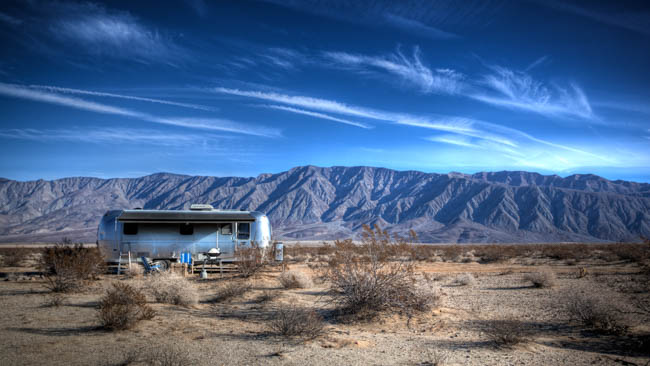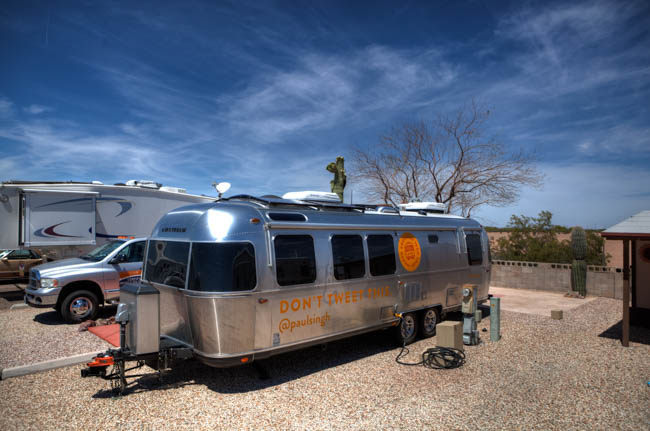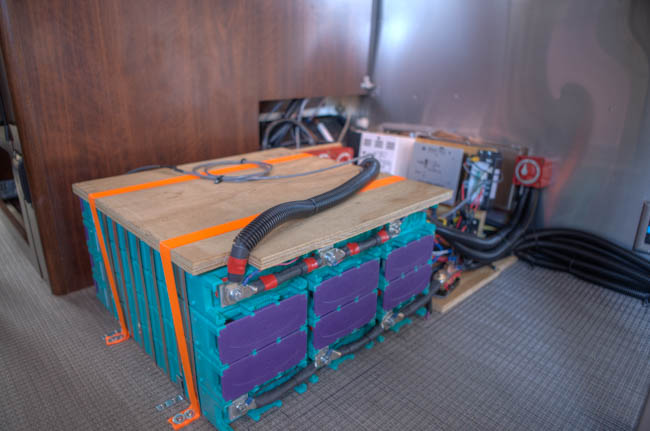
Boondocking has become very popular in the RV community. Solar helps you keep the open spaces quiet.
RV Solar
Are you the type of RVer who likes to get away from it all, visit national parks, or boondock in remote locations? Then solar power is the thing for you. Photovoltaic systems provide several advantages over other types of power systems. They are “stand alone systems” with no moving parts. They are noise free and don’t require fuel or produce emissions.
Many RVers are also earth conscious and educated about environmental impact. RVers are going green and reducing their carbon foot-print by conserving water, switching old light bulbs to LEDs and hooking up to solar power. Look around the campground or RV Park and you’ll see solar panels on trailer and motorhome rooftops. Some RVers are using one or two solar panels as a supplementary battery-charging power source to provide a few extra hours of TV after generator hours, or to keep batteries charged while the RV is in storage. Others are using solar as their primary power source with three or more panels to charge their batteries to run several appliances at a time. A solar system may run 12-volt DC lights and appliances, or provide AC power through an onboard inverter. Solar power is an abundant and nonpolluting energy source. They can be easily upgraded if your demand for power increases.
Your Custom RV Solar Installation
We strive to offer you the information and equipment you need to be electrically independent in your recreational vehicle. Not having to depend on a campsite with electrical hook-up adds freedom to your RVing life style. While some use “off the shelf” components intended for other applications, we use custom made solar panels and the best quality wiring and controllers available. We use systems exclusively designed for the RV Solar market, although they work well on vacation cabins as well.
We can assist your planning for a solar power system by helping you determine what level of usage you are going to require. The size of system you’ll need depends directly on the amount of power that is required (Watts), the amount of time it is used (hours) and the amount of energy available from the sun in the area where you are (hours of sun per day). A photovoltaic system has only four parts: a solar panel, a high quality wiring harness, a charge controller and a battery bank.

Precision RV can help you design the right RV Solar installation for your needs

A custom battery bank for an RV with battery storage limitations. Precision RV can help you plan your custom RV Solar system from start to finish.
RV Solar Components
Once you know the size of system required for your needs, it takes some planning to correctly mount the panels on the roof of the RV. Panels must be mounted to avoid shading from the air conditioner, TV antenna and storage pods. Not all panels are the same. With a life expectancy of 25 years or more we use solar panels that are designed specifically for RVs. Most panels have 36 cells while the ones we install have 44 cells. This increases the initial voltage output which compensates for the inherent voltage drop in most solar systems due to heat, wiring, and connections. Think of it as a solar panel on steroids.
The next part of the system is the wiring harness that connects the solar panels to the charge controller. The quality and size of the wiring is vitally important to get maximum power from your system. This is an area where some installers compromise to cut costs. We take pride in quality installation with high quality parts to get years of carefree service from your system. We also use the very best quality controllers available in the market place. Some of the less expensive and less desirable controllers function by turning the current flow off to the batteries at a set voltage. These are called “On/Off” controllers. These rarely are capable of fully charging the batteries, leading to excessive water consumption. The controllers we install use a tapering charge strategy to fully top-off the batteries and reduce water loss during charging. They also include advanced features such as LED indicator lights, LCD information screens, load-bank features that tell you how much charge remains in the batteries and temperature compensation to achieve the most efficient charging rate possible, even on cloudy days.
Deep cycle batteries are the ONLY battery type to use in a solar power electrical system. These batteries can be discharged to between 50-80 percent of its normal charged state and still be able to take another full charge. Of all the types of deep-cycle batteries available AGM (absorbed glass mat) were the best for a solar system. They have virtually no resistance to charge, thus they are ideal for solar system applications. But today many RV’ers are looking to Lithium Batteries as the next great solution. If you’d like to know more about the three primary types of deep cycle batteries and how they can be used in your RV solar power system, please review our RV Batteries page.
Please take a look at what we have to offer. Feel free to contact us for further solar system information.

You must be logged in to post a comment.